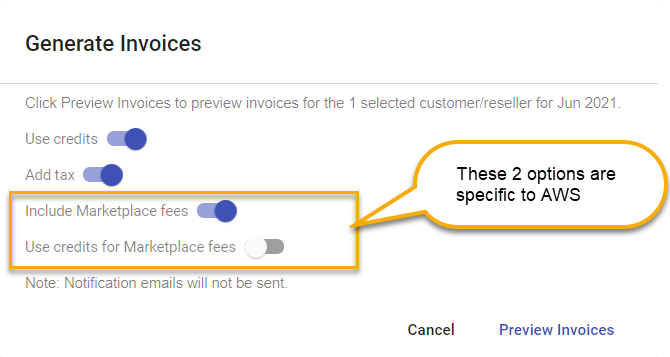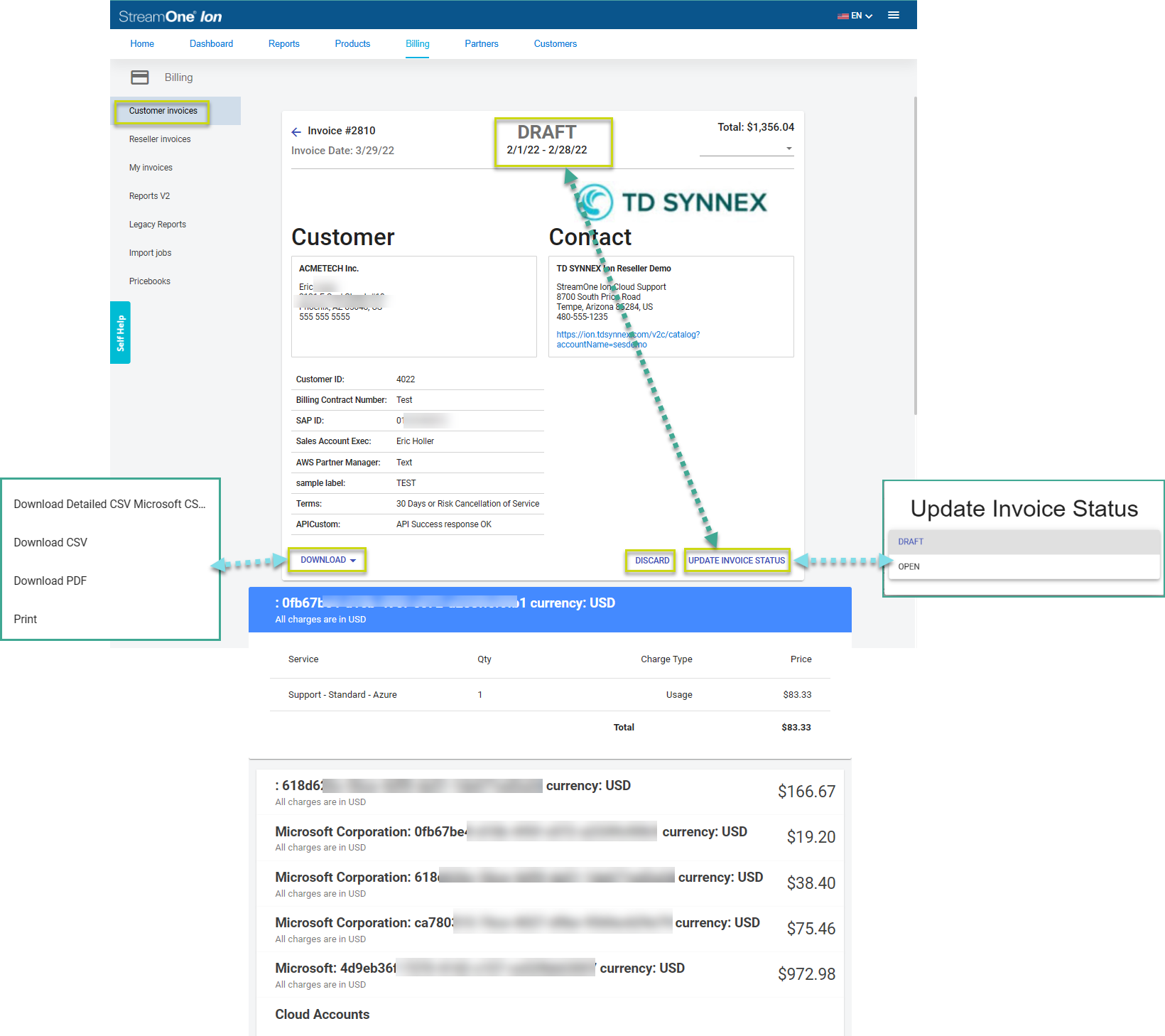Navigation Menu: Reports
TIP: To optimize platform functionality use Google Chrome.

Overview:
The list of billing reports in your platform account is subject to the cloud vendors associated with program authorization. Use the report data to analyze billing data and generate invoices. This article specifically addresses how to create customer billing statements.
Please note the following:
- It is recommended to generate invoices monthly (even if you do not use the publish and notification features of the platform). The benefit of having the document stored is to ensure the integrity of the billing values. Generating invoices in the platform locks the billing for the given period.
- Most invoices are generated based on the previous month's consumption/orders. The cloud vendors typically finalize billing data approximately 5-10 business days following a month close.
- Azure Marketplace Fees are not available in any platform reports. If you have any questions regarding your invoice, please open a support ticket.
For U.S. Partners: Before invoicing your customers, ensure that you have received the Notification of Billing Period Closure email. Please open a support ticket in StreamOne Ion if you have not received the Notification of Billing Period Closed email alert by the 15th of the month.
Important! After the billing cycle has closed, any changers to your pricebook or support plan settings will reflect in the current month and will not apply to prior months.Generate Customer Billing Statements (Invoices):
- By clicking the checkboxes next to the customer name(s).
- To select all customers, go to Options in the top-right corner and Select All.
- To clear your selections, click Options and Select None.

5) In Options, select Generate Invoices. A message dialog box displays. You can do the following:
- Apply any credits - Regardless of which cloud a credit was earned on, you can apply a credit to any invoice. For example, you could take a credit that's earned by a customer on AWS and apply it to their Azure invoice, if you are the reseller for both of those products. (If applicable)
- Include tax - If a Tax Table is created in StreamOne Ion.
- Include marketplace fees - Marketplace fees are specific to AWS. AWS Marketplace products are pass-through, and appear with $0 margin in the billing reports.
- Use Credits for Marketplace Fees - Apply any marketplace credits to the invoice, if applicable.

After Clicking the [Preview Invoices] button, the platform takes you to the billing module where one or more invoices display (in a screen name "Preview Generated Billing Statements"). Select one or more invoice entries to activate the options below:
- Approve all - Approve all of the draft invoices so you can send them to the selected customers.
- Delete - Delete the draft invoice.
- View - Review the selected invoice in draft form.
- Approve - Approve a draft invoice so you can send it to your customer.
- Finish - Finish previewing invoices and return to the reports page.

Under the Billing module, you can click Customer Invoices to navigate to the list of generated StreamOne Ion Invoices (Billing Statements). Either double-click All Customers or a specific customer in the list.

Select the Date Range to view all customer invoices from a specific billing period.

Double-click on an invoice to view. The invoice will be displayed in Draft status. Customers with access to your Customer Portal, will not be able to view billing statements in Draft status. The Billing Statements (Invoices) include customer contact information and the reseller's public profile data (your logo and contact information configured in Settings/Account information.) You can download a customer-facing CSV, Detailed CSV, PDF or print the billing statement.
*Note: Invoices are organized by product type.

Updating the Invoice Status
For more information, please read: Updating the Status of Customer Billing Statements (Invoices).You can change the invoice status to the following states:
- Draft is the Default status - When you're not ready to make the invoice visible to customers.
- Open - When you are ready to make the invoice visible to customers. When the status changes to open, StreamOne Ion can send an automated email notification to the customer. The email can contain a link to the customer portal. To view and/or the specific email template, go to Settings > Email templates > New customer invoice. Note: Your customers cannot pay you via the customer portal. The Invoices/Billing Statements are for informational purposes only*.
- Closed - When the invoice has been paid.
- Past Due - When the invoice isn't paid on or before the due date.

While viewing the invoice, you can change the currency by scrolling to the upper right corner of the Billing Statement document. Click the drop-down arrow on the right to select another currency.

Billing API
The platform supports a billing API. You will need to enable the AP and generate API keys in the Settings > Account Information screen. For more information, please read: How to Enable Platform Billing API

To view the system integration options, we have an API set defined in Swagger.
Invoice Options (For customer billing statements)

Additional Information Regarding Rounding
The reports in StreamOne Ion pull data directly from the cloud provider via an API. In some cases, the usage billing information can have 9 decimal points or more. The final billing number in the report data is rounded. This view's rounding occurs at the individual line-item level and is then rolled up. The reason for this is that you have drill down capabilities in the usage report to view. For example, in the ec2-box usage-instance type, rounding is forced between the two decimal points that are displayed. The bill, however, is not rounded.
The usage is calculated by adding all decimal points to the total and then rounding to the nearest penny. To summarize, the usage report view represents a comprehensive view of the bill because it allows you to drill down into the details. The usage will be rounded to the nearest two decimal points. The only way to reconcile the cost to "the penny" is to use the detailed billing file (DBR) that we include with the bill. The data in the usage report is always presented in a "rounded" manner.
AWS Free Tier
Troubleshooting StreamOne Ion Invoice Error Messages
If you see an error message like 'The customer with ID #123456 does not have the currency USD enabled' after generating an invoice in StreamOne Ion, it implies the Pricebook is missing and/or the Invoice currency has not been assigned inside the customer's profile.
To resolve the problem, navigate to the customer's profile, expand the Cloud Billing folder on the left side, and then click on Cloud Providers. The Pricebook and Invoice Currency are most likely missing. On the right side, click the Add button, then select the appropriate Pricebook, Invoice Currency, and Save. After the updates, try generating an invoice in StreamOne Ion. If you are still receiving and error, please open a ticket in StreamOne Ion Freshdesk, be sure to share screenshots and the customer details within the support ticket.
Video Tutorial: How to resolve errors with generating invoices in StreamOne IonError Examples:


Add the Pricebook

Select the Pricebook and Invoice Currency

